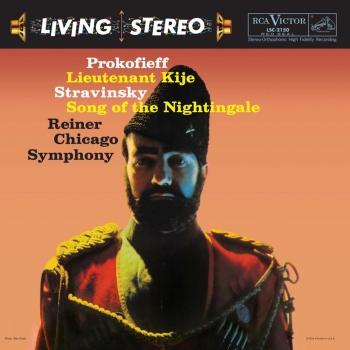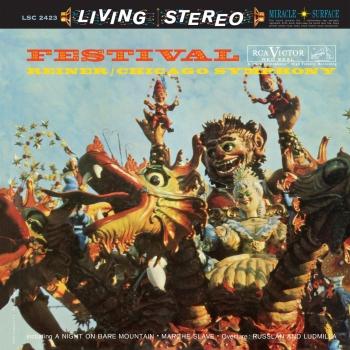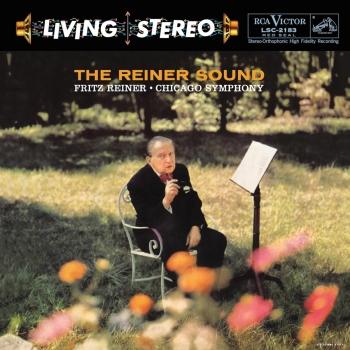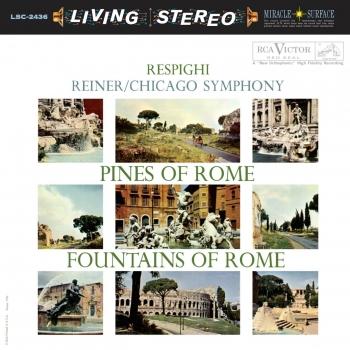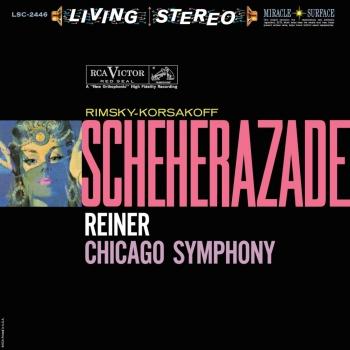
Respighi: Pines of Rome; Fountains of Rome & Debussy: La mer Chicago Symphony Orchestra & Fritz Reiner
Album Info
Album Veröffentlichung:
1995
HRA-Veröffentlichung:
15.04.2015
Label: Living Stereo
Genre: Classical
Subgenre: Orchestral
Interpret: Chicago Symphony Orchestra & Fritz Reiner
Komponist: Claude Debussy (1862-1918)
Das Album enthält Albumcover Booklet (PDF)
Entschuldigen Sie bitte!
Sehr geehrter HIGHRESAUDIO Besucher,
leider kann das Album zurzeit aufgrund von Länder- und Lizenzbeschränkungen nicht gekauft werden oder uns liegt der offizielle Veröffentlichungstermin für Ihr Land noch nicht vor. Wir aktualisieren unsere Veröffentlichungstermine ein- bis zweimal die Woche. Bitte schauen Sie ab und zu mal wieder rein.
Wir empfehlen Ihnen das Album auf Ihre Merkliste zu setzen.
Wir bedanken uns für Ihr Verständnis und Ihre Geduld.
Ihr, HIGHRESAUDIO
- Claude Debussy (1862-1918): La Mer:
- 1 I. From Dawn to Midday on the Sea 10:22
- 2 II. Play of the Waves 06:31
- 3 III. Dialogue of the Wind and the Sea 08:14
- Ottorino Respighi (1879-1936): Fountain of Rome:
- 4 The Fountain of Valle Giulia at Dawn 04:40
- 5 The Triton Fountain at Morning 02:25
- 6 The Fountain of Trevi at Midday 03:19
- 7 The Villa Medici Fountain at Sunset 05:26
- Ottorino Respighi (1879-1936): Pines of Rome:
- 8 The Pines of the Villa Borghese 02:43
- 9 Pines Near a Catacomb 06:46
- 10 The Pines of the Janiculum 06:28
- 11 The Pines of the Appian Way 05:12
Info zu Respighi: Pines of Rome; Fountains of Rome & Debussy: La mer
„Listening to these exquisite remasterings of half-century-old classic Living Presence recordings recalled a story told by a pupil of Philip Farkas (the Chicago Symphony Orchestra's principal hornist when these tapings were made). During rehearsal, conductor Fritz Reiner angrily signaled for a stop, glared at the horns, and demanded: 'Horns! Forte!' They repeated the passage, louder, and were stopped again. 'Horns! Forte!' Two more times produced the same result, after which Reiner slammed down his baton. One of the horn players pleaded, 'But, Maestro, we're playing as loud as we can.' 'I know!' snapped Reiner, 'you started at fortissimo.'
This anecdote illustrates how important it was to Reiner to get the exact loudness--or quietness--he wanted. Truly pianissimo playing is a hard thing for an orchestra to achieve, and among the things this excellent SACD remastering discloses as never before is the utterly ravishing playing of this orchestra at pianissimo, and its constant attention to dynamic level. This pays off in the final movement of Pines of Rome, where Reiner achieves a steady increase in loudness from the first tread of the Caesars' ghostly legions to the very last chord. The effect is breathtaking.
The remastering does this without at all yielding to the temptation to 'improve' the original master's dynamics by ramping up the loud parts. The result: a faithful recreation of the legendary 1959 and 1960 sonics, minus surface noise or hiss. The string sound regains its original sweetness, eliminating the slight graininess and upper-register hardness that many can hear in standard-resolution CDs. Inclusion of the third channel in the multi-track layer of the SACD helps nail down the placement of the solo winds and spreads the strings out to sections, rather than points.
The virtues of Reiner's performances are well known. In La Mer Reiner remembers that a movement called 'From Dawn Till Noon...' should begin in profound darkness. Rhythms are never rigid in this unmatched depiction of fluidity. All the delicate shadings of what is called musical Impressionism are there, but the climaxes arrive with plenty of guts. In Respighi's Fountains you can feel the dawn mists at the beginning and the magical quietness of the air at the end of the day. And the Gregorian chant evoked by the Catacombs in Pines never has made the remembered Christian martyrs sound so noble and brave.
If you know these recordings, be assured that they truly improve the sound. If you've ever wondered why old-timers rave about 1950s stereo labels like RCA Living Stereo and 'shaded dogs' (a description of the art style used for the RCA terrier on the LP label), this will answer all your questions.“ (Joseph Stevenson, ClassicsToday.com)
Chicago Symphony Orchestra
Fritz Reiner, conductor
Recorded at Orchestra Hall, Chichago February 27, 1960 (Debussy), October 24, (Respighi)
Digitally remastered
Chicago marked the confluence of two distinct, but intermingling musical strains in Chicago, IL, in the mid-'60s: an academic approach and one coming from the streets. Reed player Walter Parazaider (born March 14, 1945, in Chicago, IL), trumpeter Lee Loughnane (born October 21, 1946, in Chicago, IL), and trombonist James Pankow (born August 20, 1947, in St. Louis, MO) were all music students at DePaul University. But they moonlighted in the city's clubs, playing everything from R&B to Irish music, and there they encountered less formally educated but no less talented players like guitarist Terry Kath (born January 31, 1946, in Chicago, IL; died January 23, 1978, in Los Angeles, CA) and drummer Danny Seraphine (born August 28, 1948, in Chicago, IL). In the mid-'60s, most rock groups followed the instrumentation of the Beatles -- two guitars, bass, and drums -- and horn sections were heard only in R&B. But in the summer of 1966, the Beatles used horns on 'Got to Get You into My Life' on their Revolver album and, as usual, pop music began to follow their lead. At the end of the year, the Buckinghams, a Chicago band guided by a friend of Parazaider's, James William Guercio, scored a national hit with the horn-filled 'Kind of a Drag,' which went on to hit number one in February 1967.
That was all the encouragement Parazaider and his friends needed. Parazaider called a meeting of the band-to-be at his apartment on February 15, 1967, inviting along a talented organist and singer he had run across, Robert Lamm (born October 13, 1944, in New York, NY [Brooklyn]). Lamm agreed to join and also said he could supply the missing bass sounds to the ensemble using the organ's foot pedals (a skill he had not actually acquired at the time).
Developing a repertoire of James Brown and Wilson Pickett material, the new band rehearsed in Parazaider's parents' basement before beginning to get gigs around town under the name the Big Thing. Soon, they were playing around the Midwest. By this time, Guercio had become a staff producer at Columbia Records, and he encouraged the band to begin developing original songs. Kath, and especially Lamm, took up the suggestion. (Soon, Pankow also became a major writer for the band.) Meanwhile, the sextet became a septet when Peter Cetera (born September 13, 1944, in Chicago, IL), singer and bassist for a rival Midwest band, the Exceptions, agreed to defect and join the Big Thing. This gave the group the unusual versatility of having three lead singers, the smooth baritone Lamm, the gruff baritone Kath, and Cetera, who was an elastic tenor. When Guercio came back to see the group in the late winter of 1968, he deemed them ready for the next step. In June 1968, he financed their move to Los Angeles.
Guercio exerted a powerful influence on the band as its manager and producer, which would become a problem over time. At first, the bandmembers were willing to live together in a two-bedroom house, practice all the time, and change the group's name to one of Guercio's choosing, Chicago Transit Authority. Guercio's growing power at Columbia Records enabled him to get the band signed there and to set in place the unusual image the band would have. He convinced the label to let this neophyte band release a double album as its debut (that is, when they agreed to a cut in their royalties), and he decided the group would be represented on the cover by a logo instead of a photograph.
Chicago Transit Authority, released in April 1969, debuted on the charts in May as the band began touring nationally. By July, the album had reached the Top 20, without benefit of a hit single. It had been taken up by the free-form FM rock stations and become an underground hit. It was certified gold by the end of the year and eventually went on to sell more than two million copies. (In September 1969, the band played the Toronto Rock 'n' Roll Festival, and somehow the promoter obtained the right to tape the show. That same low-fidelity tape has turned up in an endless series of albums ever since. Examples include: Anthology, Beat the Bootleggers: Live 1967, Beginnings, Beginnings Live, Chicago [Classic World], Chicago Live, Chicago Transit Authority: Live in Concert [Magnum], Chicago Transit Authority: Live in Concert [Onyx], Great Chicago in Concert, I'm a Man, In Concert [Digmode], In Concert [Pilz], Live! [Columbia River], Live [LaserLight], Live Chicago, Live in Concert, Live in Toronto, Live '69, Live 25 or 6 to 4, The Masters, Rock in Toronto, and Toronto Rock 'n' Roll Revival.) To Guercio's surprise, he was contacted by the real Chicago Transit Authority, which objected to the band's use of the name; he responded by shortening the name to simply 'Chicago.' When he and the group finished the second album (another double) for release at the start of 1970, it was called Chicago, though it has since become known as Chicago II.
Chicago II vaulted into the Top Ten in its second week on the Billboard chart, even before its first single, 'Make Me Smile,' hit the Hot 100. The single was an excerpt from a musical suite, and the band at first objected to the editing considered necessary to prepare it for AM radio play. But it went on to reach the Top Ten, as did its successor, '25 or 6 to 4.' The album quickly went gold and eventually platinum. In the fall of 1970, Columbia Records released 'Does Anybody Really Know What Time It Is?,' drawn from the group's first album, as its next single; it gave them their third consecutive Top Ten hit.
Chicago III, another double album, was ready for release at the start of 1971, and it just missed hitting number one while giving the band a third gold (and later platinum) LP. Its singles did not reach the Top Ten, however, and Columbia again reached back, releasing 'Beginnings' (from the first album) backed with 'Colour My World' (from the second) to give Chicago its fourth Top Ten single. Next up was a live album, the four-disc box set Chicago at Carnegie Hall, which, despite its size, crested in the Top Five and sold over a million copies. (The band itself preferred Live in Japan, an album recorded in February 1972 and initially released only in Japan.) Chicago V, a one-LP set, released in July 1972, spent nine weeks at number one on its way to selling over two million copies, spurred by its gold-selling Top Ten hit 'Saturday in the Park.' Chicago VI followed a year later and repeated the same success, launching the Top Ten singles 'Feelin' Stronger Every Day' and 'Just You 'n' Me.'
The next Top Ten hit, '(I've Been) Searchin' So Long,' was released in advance of Chicago VII in the late winter of 1974. The album was the band's third consecutive chart-topper and another million-seller. 'Call on Me' became its second Top Ten single. Chicago VIII, which marked the promotion of sideman percussionist Laudir de Oliveira as a full-fledged bandmember, appeared in the spring of 1975, spawned the Top Ten hit 'Old Days,' and became the band's fourth consecutive number one LP. After the profit-taking Chicago IX: Chicago's Greatest Hits in the fall of 1975 came Chicago X, which missed hitting number one but eventually sold over two million copies, in part because of the inclusion of the Grammy-winning number one single 'If You Leave Me Now.' Chicago XI, released in the late summer of 1977, continued the seemingly endless string of success, reaching the Top Ten, selling a million copies, and generating the Top Five hit 'Baby, What a Big Surprise.' (Source: www.billboard.com)
Booklet für Respighi: Pines of Rome; Fountains of Rome & Debussy: La mer


















